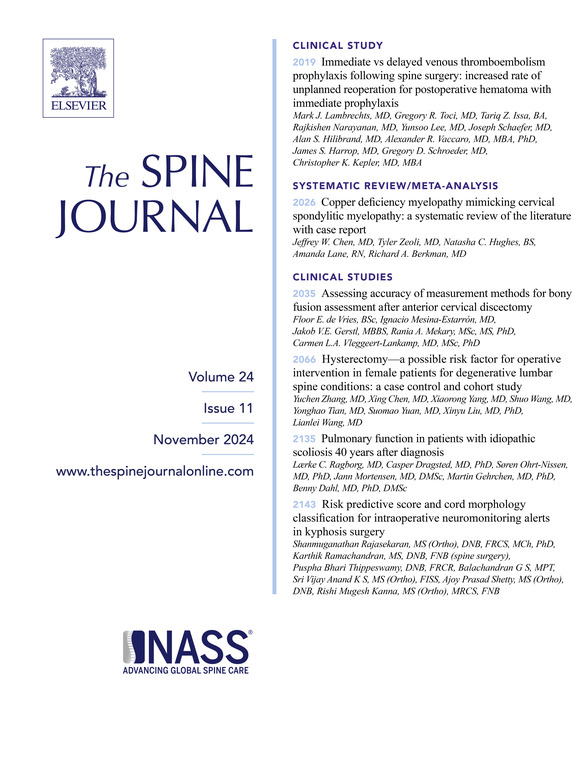Development of quantitative instrumentation for cone of economy analysis: bridging radiographic and clinical measures
IF 4.7
1区 医学
Q1 CLINICAL NEUROLOGY
引用次数: 0
Abstract
BACKGROUND CONTEXT
Postural misalignment and compromised balance are major contributors to fall risk in the elderly, leading to significant physical injuries, reduced quality of life (QOL), and increased healthcare burdens. Evaluating postural stability is critical for fall prevention. The cone of economy (CoE) concept explores the range of motion of the center of mass and head required to maintain a stable upright posture, yet its measurement remains challenging due to the limitations of existing methods.
PURPOSE
This study introduces a novel apparatus for real-time measurement of both external and internal CoEs, offering a cost-effective alternative to expensive and complex traditional methods that require extensive data processing.
STUDY DESIGN/SETTING
The study employed a controlled experimental design to develop and validate the proposed CoE measurement apparatus in a laboratory setting using a sample of healthy young adults.
METHODS
The proposed apparatus used 2 spherical measuring units to independently track pelvic and T1 vertebra motion, employing dual rotational magnetic encoders and a linear displacement sensor for precise 3D motion contour capture.
RESULTS
Validation experiments confirmed the system's reliability, achieving an average measurement error below 1.5 mm. The CoE is not an idealized cone but has an irregular conical shape, influenced by physiological factors (height and weight). The average range of sway (RoS) for external CoE at T1 was 42.7 (coronal), 47.6 (sagittal), and 12.5 cm (vertical), whereas that at the pelvic position was 14.3, , and 8 cm, respectively. The average RoS for internal CoE were smaller: (coronal), (sagittal), and 2 cm (vertical) at T1 and 8.2, 5.8, and 2.2 cm, respectively, at the pelvic position. The external CoE exhibited a larger RoS at the body's front, reflecting the foot's role in balancing forward shifts of gravity.
CONCLUSIONS
Preliminary findings highlight a stronger correlation between external CoE and height than internal CoE, establishing a foundation for CoE research with implications for fall prevention and balance assessment.
CLINICAL SIGNIFICANCE
This study introduces a reliable, cost-effective apparatus for real-time cone of economy (CoE) measurement, offering dynamic insights into postural stability, fall risk, and personalized balance assessment in clinical settings.
经济分析锥体定量仪器的发展:连接放射学和临床测量。
背景:体位失调和平衡受损是老年人跌倒风险的主要因素,导致严重的身体伤害,降低生活质量(QOL),增加医疗负担。评估体位稳定性对预防跌倒至关重要。经济锥体(CoE)概念探讨了保持稳定的直立姿势所需的重心和头部的运动范围,但由于现有方法的限制,其测量仍然具有挑战性。目的:本研究介绍了一种用于外部和内部CoEs实时测量的新型仪器,为需要大量数据处理的昂贵和复杂的传统方法提供了一种经济有效的替代方法。研究设计/环境:本研究采用对照实验设计,在实验室环境中使用健康年轻人样本开发和验证提议的CoE测量仪器。方法:该仪器采用两个球形测量单元独立跟踪骨盆和T1椎体的运动,采用双旋转磁编码器和线性位移传感器进行精确的三维运动轮廓捕获。结果:验证实验证实了系统的可靠性,平均测量误差在1.5 mm以下。CoE不是一个理想的圆锥形,而是不规则的圆锥形,受生理因素(身高和体重)的影响。T1时外部CoE的平均摆动范围(RoS)为42.7(冠状)、47.6(矢状)和12.5 cm(垂直),而盆腔位置的平均摆动范围分别为14.3、13.4和8 cm。内部CoE的平均RoS较小:T1时为10.4(冠状面)、6.9(矢状面)和2cm(垂直),盆腔位置分别为8.2、5.8和2.2 cm。外部CoE在身体前部表现出更大的RoS,反映了脚在平衡重力向前移动方面的作用。结论:初步研究结果表明,外部CoE与身高的相关性强于内部CoE,为CoE研究奠定了基础,并对预防跌倒和平衡评估具有重要意义。临床意义:本研究介绍了一种可靠的、经济锥(CoE)实时测量仪器,为临床环境中姿势稳定性、跌倒风险和个性化平衡评估提供了动态见解。
本文章由计算机程序翻译,如有差异,请以英文原文为准。
求助全文
约1分钟内获得全文
求助全文
来源期刊

Spine Journal
医学-临床神经学
CiteScore
8.20
自引率
6.70%
发文量
680
审稿时长
13.1 weeks
期刊介绍:
The Spine Journal, the official journal of the North American Spine Society, is an international and multidisciplinary journal that publishes original, peer-reviewed articles on research and treatment related to the spine and spine care, including basic science and clinical investigations. It is a condition of publication that manuscripts submitted to The Spine Journal have not been published, and will not be simultaneously submitted or published elsewhere. The Spine Journal also publishes major reviews of specific topics by acknowledged authorities, technical notes, teaching editorials, and other special features, Letters to the Editor-in-Chief are encouraged.
 求助内容:
求助内容: 应助结果提醒方式:
应助结果提醒方式:


